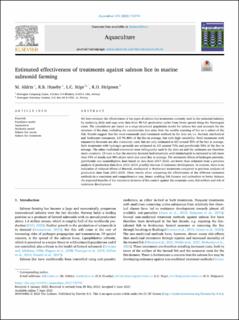| dc.contributor.author | Aldrin, Magne Tommy | |
| dc.contributor.author | Huseby, Ragnar Bang | |
| dc.contributor.author | Stige, Leif Christian | |
| dc.contributor.author | Helgesen, Kari Marie Olli | |
| dc.date.accessioned | 2024-02-22T15:05:53Z | |
| dc.date.available | 2024-02-22T15:05:53Z | |
| dc.date.created | 2023-07-10T13:06:19Z | |
| dc.date.issued | 2023 | |
| dc.identifier.citation | Aquaculture. 2023, 575 . | en_US |
| dc.identifier.issn | 0044-8486 | |
| dc.identifier.uri | https://hdl.handle.net/11250/3119437 | |
| dc.description.abstract | We here estimate the effectiveness of ten types of salmon lice treatments currently used in the salmonid industry by analysing daily and cage-wise data from 90 full production cycles from farms spread along the Norwegian coast. The calculations are based on a stage-structured population model for salmon lice and accounts for the structure of the data, including the uncertainties that arise from the weekly counting of lice on a subset of the fish. Results suggest that the most commonly used treatment methods in the data set, i.e. thermal, mechanical and freshwater treatments, kill 70–80% of the lice in average, but with high variability. Feed treatments with emamectin benzoate are also commonly used, but are only estimated to kill around 35% of the lice in average. Bath treatments with hydrogen peroxide are estimated to kill around 74% and pyrethroids 50% of the lice in average. The other medicinal treatments were infrequently used in the data set and the estimates are therefore more uncertain. Of note is that the recently licenced bath treatment with imidacloprid is estimated to kill more than 99% of sessile and 98% of pre-adult and adult lice in average. The estimated effects of hydrogen peroxide, pyrethroids and azamethiphos, here based on data from 2017–2020, are lower than estimates from a previous analysis of production data from 2011–2014, possibly because of resistance development. In contrast, there is no indication of reduced effects of thermal, mechanical or freshwater treatments compared to previous analyses of production data from 2013–2018. These results allow comparing the effectiveness of the different treatment methods in a consistent and comprehensive way, hence enabling fish farmers and authorities to better balance the expected benefits of the treatments in terms of lice control against the economic costs, fish welfare and risk of resistance development. | en_US |
| dc.description.abstract | Estimated effectiveness of treatments against salmon lice in marine salmonid farming | en_US |
| dc.language.iso | eng | en_US |
| dc.rights | Navngivelse-Ikkekommersiell-DelPåSammeVilkår 4.0 Internasjonal | * |
| dc.rights.uri | http://creativecommons.org/licenses/by-nc-sa/4.0/deed.no | * |
| dc.title | Estimated effectiveness of treatments against salmon lice in marine salmonid farming | en_US |
| dc.title.alternative | Estimated effectiveness of treatments against salmon lice in marine salmonid farming | en_US |
| dc.type | Journal article | en_US |
| dc.type | Peer reviewed | en_US |
| dc.description.version | publishedVersion | en_US |
| cristin.ispublished | true | |
| cristin.fulltext | original | |
| cristin.qualitycode | 2 | |
| dc.identifier.doi | 10.1016/j.aquaculture.2023.739749 | |
| dc.identifier.cristin | 2161690 | |
| dc.source.journal | Aquaculture | en_US |
| dc.source.volume | 575 | en_US |
| dc.source.pagenumber | 0 | en_US |

